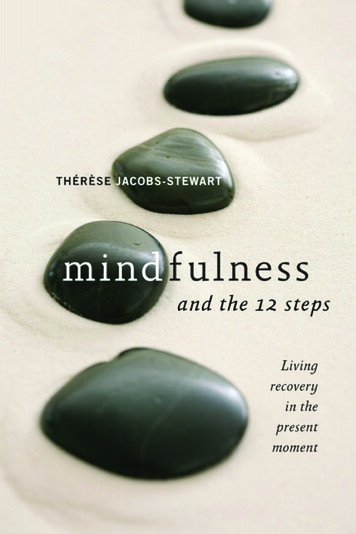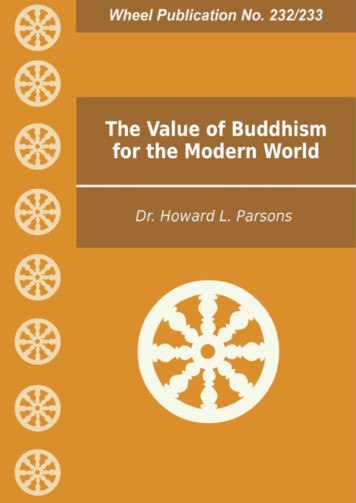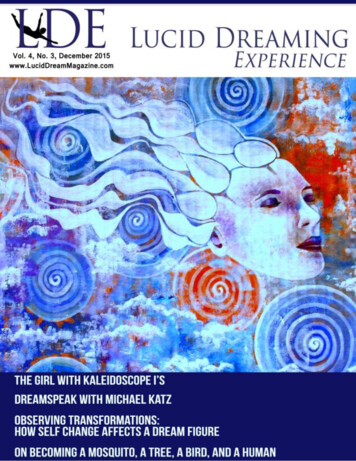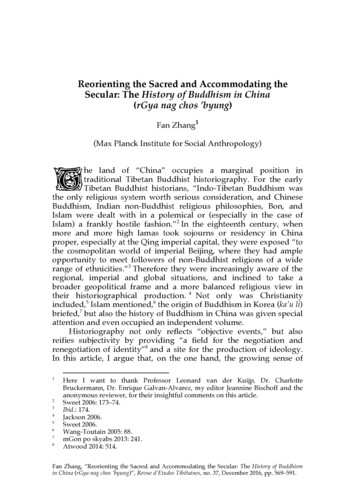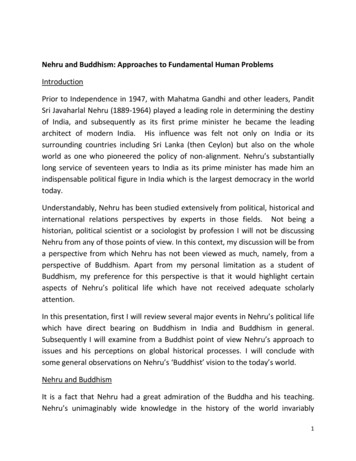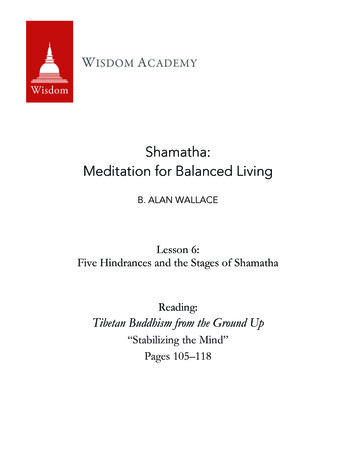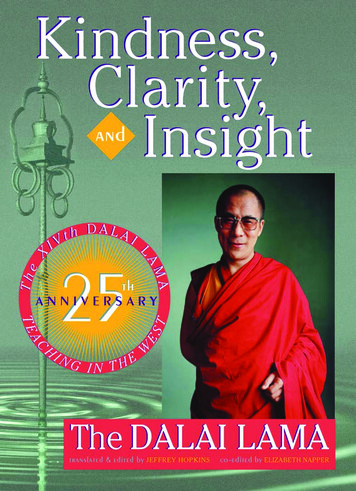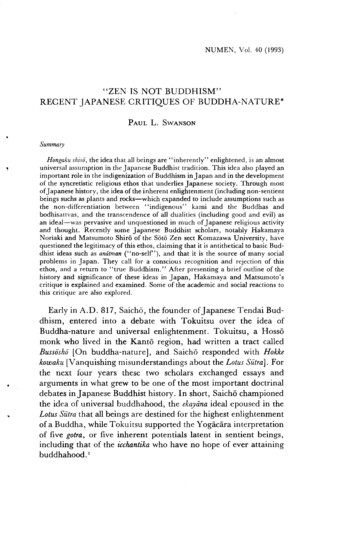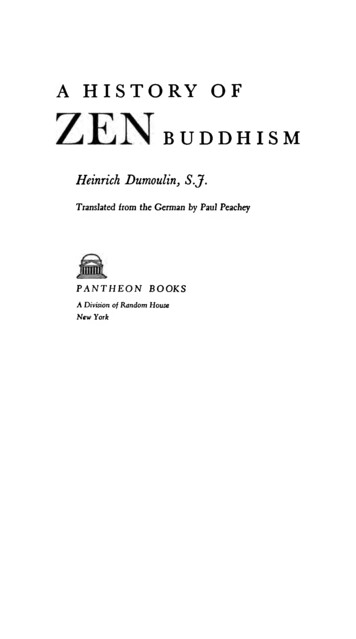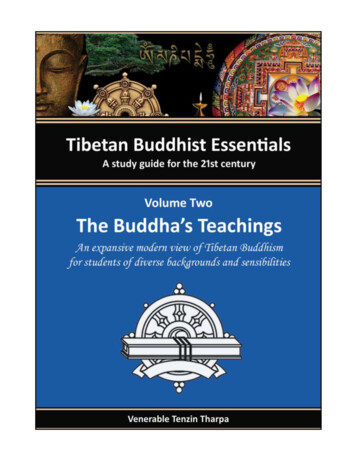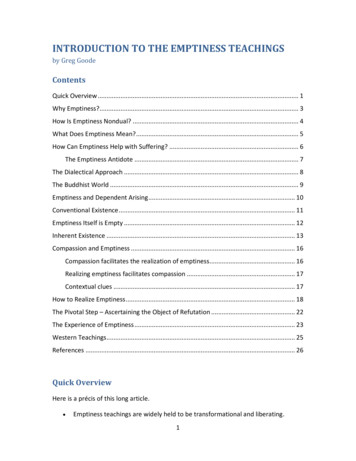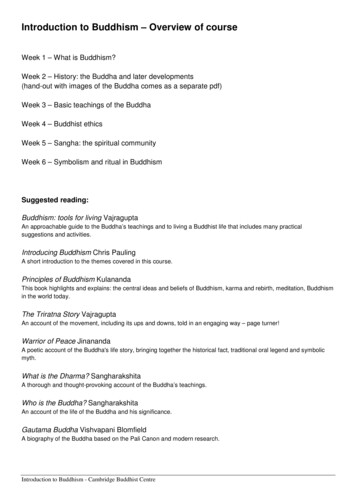
Transcription
Introduction to Buddhism – Overview of courseWeek 1 – What is Buddhism?Week 2 – History: the Buddha and later developments(hand-out with images of the Buddha comes as a separate pdf)Week 3 – Basic teachings of the BuddhaWeek 4 – Buddhist ethicsWeek 5 – Sangha: the spiritual communityWeek 6 – Symbolism and ritual in BuddhismSuggested reading:Buddhism: tools for living VajraguptaAn approachable guide to the Buddha’s teachings and to living a Buddhist life that includes many practicalsuggestions and activities.Introducing Buddhism Chris PaulingA short introduction to the themes covered in this course.Principles of Buddhism KulanandaThis book highlights and explains: the central ideas and beliefs of Buddhism, karma and rebirth, meditation, Buddhismin the world today.The Triratna Story VajraguptaAn account of the movement, including its ups and downs, told in an engaging way – page turner!Warrior of Peace JinanandaA poetic account of the Buddha's life story, bringing together the historical fact, traditional oral legend and symbolicmyth.What is the Dharma? SangharakshitaA thorough and thought-provoking account of the Buddha’s teachings.Who is the Buddha? SangharakshitaAn account of the life of the Buddha and his significance.Gautama Buddha Vishvapani BlomfieldA biography of the Buddha based on the Pali Canon and modern research.Introduction to Buddhism - Cambridge Buddhist Centre
Week 1) What is Buddhism?To lead a Buddhist life we need, above all, four things: a vision of the kind of person we could become; practical methods to help us to transform ourselves in the light of that vision; friendship to support and encourage us on the path; and a society or culture that supports us in our aspirations.The Three Jewels:The Buddha: symbol of Enlightenment, particularly asembodied in Siddhartha Gautama, the man who discovered thepath to human perfection.The Dharma: symbol of the Path itself: a host of insights andpractical guidelines that help the individual to plot a coursetowards Enlightenment.The Sangha: symbol of the fellowship enjoyed betweenthose whose lives are based on the quest for Enlightenment.Introduction to Buddhism - Cambridge Buddhist Centre
Week 2) History: the Buddha and later developmentsThe Buddha’s Life Story* Born into a life of luxury about 500 BCE* 4 Sights: Sickness, Old age, Death, Holy man* Leaving Home* Asceticism* Middle Way between luxurious living and asceticism* Enlightenment (Nirvana)* 45 Years of teaching* Parinirvana (death of physical body)The Main Phases of Buddhist DevelopmentApproximateEra uralLanguage500 BCE – 0CEEarlyBuddhism(alsoknown ntEthical/PsychologicalSouthern Asia(Sri Lanka,Burma,Thailand etc.)PaliZen, yanaBodhisattvaMetaphysical/DevotionalNorthern Asia(China, Korea,Japan ore altruistic,Laity & womenvalued more,UniversalSiddhaRitualistic/YogicTibet, Japan0– 500 CE500 – 1000CEIntroduction to Buddhism - Cambridge Buddhist CentreDirectexperienceSanskrit
Week 2) History of Buddhism extractsEarly BuddhismExperiences are preceded by mind, led by mind, and produced by mind. If one speaks or acts withan impure mind, suffering follows even as the cartwheel follows the hoof of the ox.Experiences are preceded by mind, led by mind, and produced by mind. If one speaks or acts witha pure mind, happiness follows like a shadow that never departs.Those who entertain such thoughts as ‘He abused me, he beat me, he conquered me, he robbedme,’ will not still their hatred.Those who do not entertain such thoughts as ‘He abused me, he beat me, he conquered me, herobbed me,’ will still their hatred.Not by hatred are hatreds ever pacified here (in the world). They are pacified by love. This is theeternal law.The Dhammapada[The Buddha addressed the monks:]Once upon a time, monks, a bamboo acrobat, setting himself upon his bamboo pole, addressedhis assistant Medakathalika: "Come, my dear Medakathalika, and climbing up the bamboo pole,stand upon my shoulders.""Okay, master" the assistant Medakathalika replied to the bamboo acrobat; and climbing up thebamboo pole she stood on the master's shoulders.So then the bamboo acrobat said this to his assistant Medakathalika: "You look after me, my dearMedakathalika, and I'll look after you. Thus with us looking after one another, guarding oneanother, we'll show off our craft, receive some payment, and safely climb down the bamboo pole."This being said, the assistant Medakathalika said this to the bamboo acrobat: "That will not do atall, master! You look after yourself, master, and I will look after myself. Thus with each of uslooking after ourselves, we'll show off our craft, receive some payment, and safely climb downfrom the bamboo pole. That's the right way to do it!"[The Buddha said:]Just like the assistant Medakathalika said to her master: "I will look after myself," so should you,monks, practice the establishment of mindfulness. You should (also) practice the establishment ofmindfulness (by saying) "I will look after others."Looking after oneself, one looks after others. Looking after others, one looks after oneself.And how does one look after others by looking after oneself? By practising (mindfulness), bydeveloping (it), by doing (it) a lot. And how does one look after oneself by looking after others? Bypatience, by non-harming, by loving kindness, by caring (for others).Sedaka Sutta – The Bamboo AcrobatMahayanaMay I be a light for those in need of light. May I be a bed for those in need of rest. May I be aservant for those in need of service, for all embodied beings.For embodied beings may I be the wish-fulfilling jewel, the pot of plenty, the spell that alwaysworks, the potent healing herb, the magical tree that grants every wish, and the milch-cow thatsupplies all wants. Just as earth and the other elements are profitable in many ways to theinnumerable beings dwelling throughout space. So may I be sustenance of many kinds for therealm of beings throughout space, until all have attained release.Santideva, The BodhicaryāvatāraIntroduction to Buddhism - Cambridge Buddhist Centre
Thus shall you think of all this fleeting world:A star at dawn, a bubble in a stream;A flash of lightening in a summer cloud,A flickering lamp, a phantom, and a dream.The Diamond SutraVajrayanaThe Human body at peace with itself,Is more precious than the rarest gem.Cherish your body, it is yours this one time only.The human form is won with difficulty,It is easy to lose.All worldly things are brief,Like lightning in the sky;This life you must knowAs a tiny splash of a raindrop;A thing of beauty that disappearsEven as it comes into being.Therefore set your goalMake use of every day and nightTo achieve it.Tsongkapa.Oh, Tara, holy liberator, swift-acting mother, wepray and invoke your blessings;Please watch over us, protect us, and hold us inyour loving embrace.Traditional Tibetan prayerIntroduction to Buddhism - Cambridge Buddhist Centre
Week 3) The Buddha's Noble Eightfold Path(The fourth of the Four Noble Truths: Suffering, Cause, Ceasing, Way)Note: the word ‘perfect’ translates the pali word sammawhich means something like ‘whole’,’ complete’, ‘integral’– because all the limbs are practised interdependentlywith each other.Introduction to Buddhism - Cambridge Buddhist Centre
Week 3) The Teaching of the BuddhaThe Buddha'sTranscendental InsightExpressedConceptuallyConditioned Co-productionForexampleThis being, that becomes,From the arising of this, that arises;This not becoming, that does not become;From the ceasing of this, that ceases.Four Noble Truths:1. Suffering2. Cause of suffering3. Cessation of suffering4. Way leading to the cessationof sufferingNoble Eightfold Path“Path of Vision”1 Perfect Vision2 Perfect Emotion3 Perfect Speech4 Perfect Action}5 Perfect Livelihood6 Perfect Effort“Path of Transformation”7 Perfect Mindfulness8 Perfect MeditationThe limbs of the Eightfold Path are sometimes grouped toform the Threefold Path ofEthics(3, 4, 5)Meditation(6, 7, 8)Wisdom(1, 2)Introduction to Buddhism - Cambridge Buddhist Centre
Week 4) Buddhist EthicsIdeas for more ethical behaviour during this coming week1 Abstaining from killing/ developing loving kindnessWrite to a friend you haven’t been in touch with for some time.Be more patient with children one day.Be vegetarian for a day.Pick up a piece of rubbish from the street.Say thank you and mean it.Eat a bit more healthily.Give permission to yourself to be human when noticing how you are feeling.Buy a (birthday) present for someone.2 Not taking the not given/ generosityReduce waste by recycling or reusing.Walk or cycle rather than driving one day.Give up the need to be right.Give someone some time.Give someone some space – listening to them.Allow someone out in front of you either in a car or leaving a train.Give some money to charity.Acknowledge people, such as Big Issue sellers, who are asking for money even if you don’t give any money.3 No sexual misconduct/ developing stillness, simplicity and contentmentMeditateDo something which feeds yourself, such as listening to refining music, sitting quietly.Eat more frugally for a day.Spend some time outside enjoying nature.Avoid negativity, and instead notice what is good during a day.Avoid looking through catalogues that encourage craving.Don’t follow the news for a day if you find that it encourages dissatisfaction in you.4 Telling the truthAvoid gossip.Be honest in business dealings as far as you are able.Be frank – kindly and usefully, when talking to a friend.Be more truthful with yourself about how you are feeling.Avoid exaggerating or minimising when telling someone what has happened to you.Don’t over-generalise, ‘This is difficult – everything’s such an effort’.5 Avoid drugs and intoxicants/ becoming more mindfulWhen listening to someone, be more mindful of them rather than what you want to say next.Do fewer things at once while waiting for a kettle to boil.Use a mindfulness trigger, such as the phone ringing.Before starting the car take a moment to be mindful of your body.Observe the effect something has on you, for example reading the paper or watching a particular TV programme.Take the time out to be mindful of the sensations of breathing for three breaths.Be more aware of the body when going up or down stairs.Focus on eating one mouthful of food without doing anything else at the same time.Have a day without alcohol.Introduction to Buddhism - Cambridge Buddhist Centre
Week 4) Buddhist EthicsThe Five PreceptsDo not underestimate good thinking, ‘It will not approach me.’ A water-pot becomes full by theconstant falling of drops of water. Similarly, the wise person little by little fills themselves withgood.The Buddha (from The Dhammapada)I undertake to abstain from taking lifeWith deeds of loving kindness, I purify my bodyI undertake to abstain from taking the not-givenWith open-handed generosity, I purify my bodyI undertake to abstain from sexual misconductWith stillness, simplicity and contentment, I purify my bodyI undertake to abstain from false speechWith truthful communication, I purify my speechI undertake to abstain from taking intoxicantsWith mindfulness clear and radiant, I purify my mindThe rain has stopped, the clouds have drifted away,and the weather is clear again.If your heart is pure, then all things in your world are pure.Abandon this fleeting world, abandon yourself,Then the moon and flowers will guide you along the Way.RYOKANIntroduction to Buddhism - Cambridge Buddhist Centre
Week 5) Sangha – The Spiritual CommunityThe Triratna Buddhist CommunityThe Triratna Buddhist Order, which was founded by Sangharakshita in 1968, forms the heart ofthe Triratna Buddhist Community.The Triratna Buddhist Community is open to all those who wish to practise Buddhism within it orwho are sympathetic to its approach. Everyone who has contact with Triratna is considered afriend, however someone who wants to make a particular connection with the Triratna BuddhistCommunity and develop friendships with members of the Order can ask to become a Mitra (‘friend’in Sanskrit).MitrasBecoming a Mitra marks a deepening of involvement. People ask to become a Mitra when they:1. Consider that they are Buddhists.2. Want to live in accordance with the five ethical precepts3. Believe that the Triratna Buddhist Community is the appropriate spiritual community for them.There is a simple ceremony to mark becoming a mitra. As far as possible, Order Members try toensure that the spiritual needs of Mitras are met. There are special activities for mitras, includingspecific retreats, and study groups.Order membersThe Triratna Buddhist Order is a spiritualcommunity of men and women who have pledgedthemselves to following the Buddhist path toEnlightenment. Every Order Member undertakes topractise a traditional set of ten ethical precepts.All Order Members take the same precepts, andpractise on an equal basis.The Triratna Buddhist Order is a radical alternativeto most forms of Buddhism in Asia, wherepractitioners are either monastic or lay. Our Orderis open to anyone – regardless of race or genderor lifestyle – who is sincerely and effectivelycommitted to the Buddhist path. Order memberstry to lead a wholehearted Buddhist life, bringing adharmic perspective to all aspects of their life.They are not monks or nuns. What matters is notthe lifestyle that Order members adopt, but thespiritual commitment they have made: commitmentis primary, lifestyle is secondary.Anyone can ask to join the Order. There isordination training that consists of retreats, study,developing friendships with Order members, anddeepening one’s personal practice.Introduction to Buddhism - Cambridge Buddhist Centre
Week 5) Sangha – The Spiritual CommunityTriratna History and Distinctive CharacteristicsTriratna is Sanskrit for ‘Three Jewels’ and refers to the Buddha, Dharma (his teaching) and Sangha (the spiritualcommunity).Chronology1964Sangharakshita, the founder of the movement, returns to England after 20 years inIndia practising Buddhism.1967Founding of the Friends of the Western Buddhist Order (FWBO)1968Founding of the Western Buddhist Order. 12 men and women ordained.1978Indian wing of the FWBO founded.2000Sangharakshita hands on the headship of the order to the College of PublicPreceptors.2004The leadership of the movement devolves further and individual centres have greaterautonomy.2010The name of the Order is changed to the Triratna Buddhist Order and the movement(FWBO) to the Triratna Buddhist Community.2011There are currently over 1730 order members spread over about 30 countries.Distinctive characteristicsThe movement is ecumenical. Triratna is not identified with any particular strandof Buddhism or Buddhist school, but draws inspiration from whatever seemsappropriate to here and now.The movement is unified. The Triratna Buddhist Order ordains men and women onan equal footing - unlike most traditional Buddhist schools. Single-sex activitiesare encouraged as important for spiritual growth, but men and women areconsidered equally able to practise and develop spiritually.The act of Going for Refuge is central. Going for Refuge to the Three Jewels iswhat makes someone a Buddhist. So everyone in the Triratna BuddhistCommunity is encouraged to place the Three Jewels at the centre of their lives.Spiritual friendship. Spiritual friendship is friendship based on our highest values especially the Three Jewels. Spending as much time as possible with friendswho share our highest ideals supports ethical living.Team based right-livelihood. Working together in teams, in the spirit ofgenerosity, and with a focus on ethics, is a transformative practice. Triratna hasbeen a pioneer in the area of right-livelihood, operating a number of successfulbusinesses.Art. The arts help us to broaden our sympathies and to extend our experience; theyenlarge our imaginations, they refine and direct our emotions. At their best andgreatest they may be bearers of spiritual values, values which in principle areidentical with those of the Dharma, values which can help us to transform ourlives.Introduction to Buddhism - Cambridge Buddhist Centre
Week 6) Symbolism and Ritual in BuddhismIntroduction to Buddhism - Cambridge Buddhist Centre
Week 6) Symbolism and Ritual in BuddhismIntroduction to Buddhism - Cambridge Buddhist Centre
Week 6) Symbolism and Ritual in BuddhismTransference of MeritsMay the merit gainedIn my acting thusGo to the alleviation of the suffering of all beings.My personality throughout my existences,My possessions,And my merit in all three ways,I give up without regard to myselfFor the benefit of all beings.Just as the earth and other elementsAre serviceable in many waysTo the infinite number of beingsInhabiting limitless space;So may I becomeThat which maintains all beingsSituated throughout space,So long as all have not attainedTo peace.Introduction to Buddhism - Cambridge Buddhist Centre
Introduction to Buddhism - Cambridge Buddhist Centre Week 1) What is Buddhism? To lead a Buddhist life we need, above all, four things: a vision of the kind of person we could become; practical methods to help us to transform ourselves in the light of that vision; friendship to support and encourage us on the p
